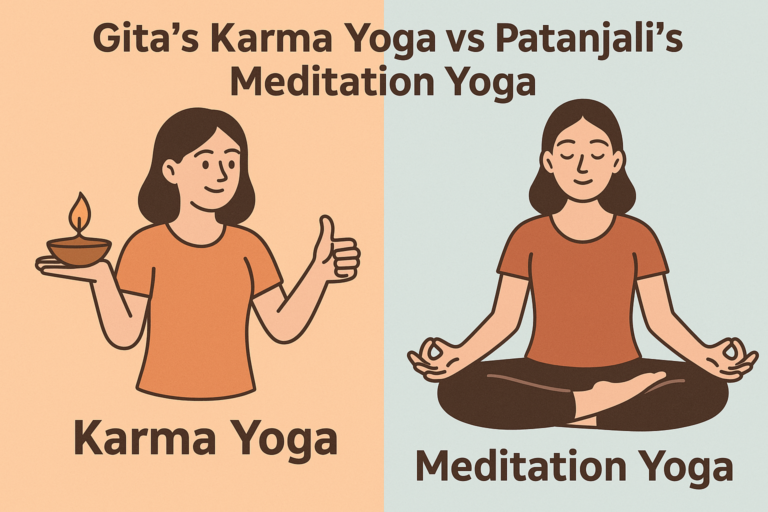🧭 Yoga Meaning in Gita and Patanjali | Yujira Explained
🧾Yogic Quotes from Gita and Patanjali
Introduction to “Yujira” and the Yoga Philosophy
What comes to your mind when you hear the word Yoga? Stretching? Meditation? Instagram-worthy poses? Well, the Sanskrit term “Yujira”, the root of “Yoga”, carries a much deeper, richer meaning. It implies “to unite, to join, or to connect”—not just physically, but spiritually and mentally.
In this article, we explore how this word evolves into two iconic interpretations from two timeless scriptures: The Bhagavad Gita and Patanjali’s Yoga Sutras. One emphasizes skillful action, the other highlights mental stillness.

Tracing the Etymology of “Yujira”
Derived from the root “Yuj”, Yujira points to a binding connection—between self and higher consciousness, body and mind, and most importantly, between action and awareness.- “Yuj” = To yoke, unite
- “Ira” = Indicative of a continuous process
Yoga in the Bhagavad Gita
The Bhagavad Gita, set in the chaos of a battlefield, introduces us to a practical and dynamic form of Yoga. Lord Krishna tells Arjuna not to renounce action, but to perform it without attachment.“Yogah Karmasu Kaushalam” – Skill in Action
Translated as “Yoga is skill in action”, this verse (Bhagavad Gita 2.50) brings us a revolutionary idea: Yoga is not about escape but engagement, done right.A Call to Selfless Action
Krishna promotes Nishkama Karma Yoga—acting without selfish desires. It’s not just what you do, but how mindfully and ethically you do it.Yoga as a Lifestyle in Gita
From food habits to mental discipline, Krishna expands Yoga beyond the mat. It becomes a life strategy, blending responsibility with spirituality.Patanjali’s Yogasutra and the Essence of Yoga
Fast-forward to Patanjali’s time, and the idea of Yoga becomes inward-looking.“Chitta Vritti Nirodha” – Stillness of the Mind
Patanjali opens his Yoga Sutras with a clear definition: “Yogaḥ citta-vṛtti-nirodhaḥ” Translation? Yoga is the cessation of the fluctuations of the mind.The Eight Limbs of Patanjali Yoga
Also known as Ashtanga Yoga, Patanjali’s path includes:- Yama – Ethics
- Niyama – Personal Discipline
- Asana – Postures
- Pranayama – Breath Control
- Pratyahara – Sense Withdrawal
- Dharana – Concentration
- Dhyana – Meditation
- Samadhi – Blissful Absorption
Mental Mastery and Meditation
Unlike Gita’s focus on engagement, Patanjali aims for detachment. Stillness becomes the superpower.Comparative View: Gita vs Patanjali on Yoga
Both perspectives are valid but serve different life needs.External Action vs Internal Awareness
- Gita: Act mindfully
- Patanjali: Withdraw and observe
Integration of Karma, Bhakti, and Jnana Yoga
Gita combines Action (Karma Yoga), Devotion (Bhakti Yoga), and Knowledge (Jnana Yoga). It’s holistic, multitasking spiritual fitness.Philosophical Depth: Yoga as Union
At their core, both agree on one thing: Yoga is a union.- Union with Self
- Union with Truth
- Union with Divinity
Modern Understanding of Yoga: A Misconception?
Let’s be honest—today’s yoga world is obsessed with the body, not the being.- Is Yoga just stretching?
- Is mindfulness enough?
Benefits of Following Ancient Yoga Paths
Why should we care what the Gita or Patanjali said? Here’s why.Mental Clarity and Peace
Both systems are ancient mental detox tools—clearing the emotional fog.Ethical Living and Spiritual Growth
Yama and Niyama = Your daily inner checklist. Karma Yoga = Your daily outer checklist. Together? They build a balanced, meaningful life.Bullet List: Core Differences Between Gita and Patanjali Yoga
- Gita: Yoga = Skill in Action
- Patanjali: Yoga = Mind Control
- Gita: Engage with life
- Patanjali: Detach from distractions
- Gita: Multi-yogic blend (Karma, Bhakti, Jnana)
- Patanjali: Systematic mental purification
How Can We Apply These Teachings Today?
Simple ways to integrate both:- Start your day with a Gita verse and reflection
- Mid-day check-in: Are you acting without ego?
- Evening unwind: 10 mins of breathwork or meditation
Conclusion: Which Path to Choose?
The best answer? Both. Think of Bhagavad Gita Yoga as the engine and Patanjali Yoga as the brakes. We need motion and stillness, effort and ease. Life is not either/or—it’s a dance between doing and being. Let’s yoke both. That’s true “Yujira”.FAQs on Yoga, Gita, and Patanjali
1. Is Yoga from the Gita or Patanjali better? It depends on your goals—Gita guides action, Patanjali trains awareness. 2. Can I follow both styles together? Absolutely! Many spiritual seekers balance both for inner and outer alignment. 3. What’s the difference between Karma Yoga and Ashtanga Yoga? Karma Yoga is about ethical action; Ashtanga is about spiritual discipline. 4. Do I need to be religious to practice Yoga? Not at all. Yoga is spiritual, not religious. Anyone can practice it. 5. Are modern yoga classes missing something? Yes, often the mental and ethical dimensions are skipped. Real Yoga is holistic.🔍



